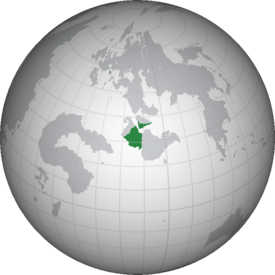Liberto-Ancapistan: Difference between revisions
mNo edit summary |
mNo edit summary |
||
| Line 65: | Line 65: | ||
== Etymology == | == Etymology == | ||
The English name ''Liberto-Ancapistan'' is an anglicisation of the Basaquese ''Libertarya-Ancapistan''. This is derived from Liberto-Ancapistan's predecessor, the Liberto-Ancapistanian Alliance (Basaquese: ''Tifaqa Libertari-Ancapistani''), which itself was derived from member states Libertaria and Ancapistan. The former's name was originally a Santian exonym, used to describe the area of Basaquastan outside the Santian Empire - a 'free land'. The latter's name, meaning 'land of the Ancapi', refers to the Ancapi, a tribe of the Kimia Culture which existed | The English name ''Liberto-Ancapistan'' is an anglicisation of the Basaquese ''Libertarya-Ancapistan''. This is derived from Liberto-Ancapistan's predecessor, the Liberto-Ancapistanian Alliance (Basaquese: ''Tifaqa Libertari-Ancapistani''), which itself was derived from member states Libertaria and Ancapistan. The former's name was originally a Santian exonym, used to describe the area of Basaquastan outside the Santian Empire - a 'free land'. The latter's name, meaning 'land of the Ancapi' in classical Basaquese (also called classical Nizmstani), refers to the Ancapi, a tribe of the Kimia Culture which existed during the last centuries of the 1st millenium BCE. | ||
== History == | == History == | ||
Revision as of 23:41, 28 January 2022
This article is incomplete because it is pending further input from participants, or it is a work-in-progress by one author. Please comment on this article's talk page to share your input, comments and questions. Note: To contribute to this article, you may need to seek help from the author(s) of this page. |
Federal Republic of Liberto-Ancapistan Komaria Federale a Libertarya-Ancapistan | |
|---|---|
| Motto: "Azadî yan mirin" "Freedom or Death" | |
| Anthem: "Graveyard of Conquerors" | |
 Location of Liberto-Ancapistan | |
| Capital and largest city | Liberty City |
| Official languages | Basaquese, Santian |
| Recognised regional languages | Old Farstani, Fayrean, Mhertag |
| Ethnic groups | Basaquastanians, Santians, Fayreans, Mhertag |
| Demonym(s) | Liberto-Ancapistanian |
| Government | Federal parliamentary republic |
• Chancellor | Casimir Bergen |
• Vice-Chancellor | Sabah Shamoud |
| Legislature | Parliament |
| Senate | |
| House of Commons | |
| Establishment | |
• Formation of Liberto-Ancapistanian Alliance | 12th April 1944 |
• Unification of Liberto-Ancapistan | 21st March 1955 |
| Area | |
• Total | 1,450,077 km2 (559,878 sq mi) |
| Population | |
• 2025 estimate | 68,845,000 |
• 2018 census | 67,684,853 |
• Density | 47.48/km2 (123.0/sq mi) |
| GDP (PPP) | 2025 estimate |
• Total | 3.9417 trillion Rovas |
• Per capita | 57,255 Rovas |
| GDP (nominal) | 2025 estimate |
• Total | 4 trillion Rovas |
• Per capita | 58,101 Rovas |
| Gini (2025) | 54.1 high |
| HDI (2025) | very high |
| Currency | Fiat (LAF) |
| Time zone | UTC-6 |
| Date format | dd-mm-yyyy |
| Driving side | left |
| Calling code | +55 |
| ISO 3166 code | LTA |
| Internet TLD | .la |
Liberto-Ancapistan (Basaquese: Libertarya-Ancapistan), officially the Federal Republic of Liberto-Ancapistan, is a transcontinental nation spanning southern Evrosia and overseas Autonomous Territories in western Evrosia, Elisia, Antartica and Takaria. Situated primarily across the islands of Promeridona and Santia, it covers an area of 1,450,077 square kilometres (559,878 sq mi) with a population of 68.8 million in 7 constituent Provinces and 3 Autonomous Territories. Liberto-Ancapistan borders the Velika Tzarska Empire, the Imperiale Arabic Union, Baccara, Hockeyyekcoh and Aether Inc. in Evrosia, Alkamistan in Takaria, Northshires in western Elisia and Cannonio as well as the Super Best Dutch Empire in Antartica. It is a member of the United Federation of Telrova. Liberto-Ancapistan is a federal parliamentary republic with its capital in Liberty City, the country's largest city and main economic centre; other major urban areas include Sades, Compacipo, Dewisburgh, Port Rand and Orafars.
Etymology
The English name Liberto-Ancapistan is an anglicisation of the Basaquese Libertarya-Ancapistan. This is derived from Liberto-Ancapistan's predecessor, the Liberto-Ancapistanian Alliance (Basaquese: Tifaqa Libertari-Ancapistani), which itself was derived from member states Libertaria and Ancapistan. The former's name was originally a Santian exonym, used to describe the area of Basaquastan outside the Santian Empire - a 'free land'. The latter's name, meaning 'land of the Ancapi' in classical Basaquese (also called classical Nizmstani), refers to the Ancapi, a tribe of the Kimia Culture which existed during the last centuries of the 1st millenium BCE.
History
WIP

